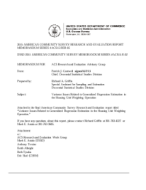Variance Issues Related to Generalized Regression Estimation in the Housing Unit Weighting Operation
Variance Issues Related to Generalized Regression Estimation in the Housing Unit Weighting Operation
We discovered that variances of some 5-year estimates have issues related to the use of generalized regression modeling which is not used in the 1-year estimates. For example, the standard error (SE) of the 5-year estimate for total occupied housing units in the United States is larger than the corresponding 1-year estimate. This report presents results of an investigation to determine if there are any underlying causes of this. Another issue investigated is the question of whether the generalized regression process introduces bias into the American Community Survey (ACS) estimates.
The concern for variances of 5-year national level estimates larger than variances of the corresponding 1-year estimates was determined to be more properly expressed as a concern about mean squared error (ratio estimation bias only) of 5-year national level estimates that are larger than the mean squared error of the corresponding 1-year estimates. This concern only applies at the national level and appears to be caused by small ratio estimation biases due to generalized regression at the weighting area (tract) level aggregating to high levels where, although relatively small, they grow in relation to the sampling variance.
The small biases when summed to the county, state, and national level resulted in the conclusion that there is no evidence of meaningful systematic bias (not limited to ratio estimation bias). Systematic bias pushes error in the same direction over aggregation and would cause higher biases at the county, state, and national level than seen here.
Others in Series
Working Paper
Working Paper
Working Paper




